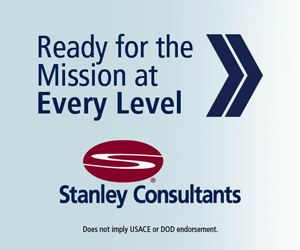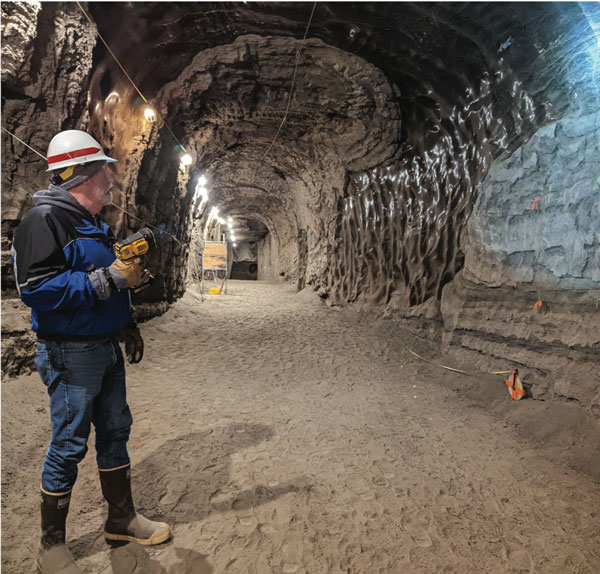
9 minute read
USACE Military Programs
from America's Engineers: The People, Programs, and Projects of the U.S. Army Corps of Engineers '24-'25
Material support for Soldiers and their families
BY CRAIG COLLINS, AMERICA'S ENGINEERS
It felt like a homecoming. In 2015, when Brig. Gen. Kirk Gibbs first assumed a leadership role within the U.S. Army Corps of Engineers, commanding the Los Angeles District, he and his family were returning to California. From 2002 to 2004, Gibbs was stationed at Fort Irwin, located about 150 miles northeast of Los Angeles. His wife, a nurse, worked at the fort’s medical facility, Weed Army Community Hospital. Built in 1966, Gibbs remembered an outdated and inefficient hospital with services scattered among 17 buildings. Returning a decade later, he was glad that a new hospital was being built.
However, the project hit roadblocks. “The partnership among the contractor, the stakeholders, and the Corps wasn’t optimal,” Gibbs recalled. “That’s when I learned the value of partnering. Eventually, we united through collaborative sessions, working toward a shared vision for the new hospital.”

In 2017, a brand-new, $211 million Weed Army Community Hospital opened with consolidated medical units. It was the third U.S. hospital to earn a Leadership in Energy and Environmental Design (LEED) Platinum rating. The Department of Defense’s (DOD) only carbon-neutral hospital, its considerable energy requirements –including extensive air conditioning for the Mojave Desert climate – are met by solar power and other renewable sources, making it a net-zero certifiable facility.
advertisement

“We became a cohesive team and delivered a quality project on time and within budget,” Gibbs said. “Now, everybody at Fort Irwin raves about the hospital’s level of care.”
Gibbs continued witnessing the power of partnerships through military construction projects, spanning Korea to Alaska, while commanding USACE’s Pacific Ocean Division. Working closely with installation leaders, contractors, and the Republic of Korea, the Division has shepherded the multi-year Korea Transformation Program, aimed at enhancing life for DOD personnel stationed throughout South Korea.

This transformation’s centerpiece is the Yongsan Relocation Program, a joint effort between the United States and Republic of Korea to relocate DOD operations to U.S. Army Garrison (USAG) Humphreys, near the city of Pyeongtaek. The sprawling base boasts a command headquarters, family housing, office buildings, barracks, a shopping center, and a golf course. In September 2023, USACE’s Far East District broke ground on a new elementary school for service members’ children.
Recently completed high-rise housing towers at USAG Humphreys feature American-style floorplans, playgrounds, and recreational areas, with easily accessible schools, gyms, libraries, and other amenities. Since 2009, 850 units have been built in 12 housing towers. The last three towers achieved LEED Gold certification. “They’re more water- and energy-efficient, which improves the quality of life for service members and their families,” Gibbs said.
Leveraging Expertise
In August 2024, Gibbs became Deputy Commanding General for USACE’s Military and International Operations. His chief responsibilities include military and installation readiness, national and regional security, and contingency response.
Gibbs assumes his role at a time of unprecedented demand for USACE expertise. “In the past ten years, our workload has grown from $20 billion to $90 billion,” Gibbs said. “We’ve also become an agency of 40,000 people, the largest workforce in our history.”

About 11,000 of USACE’s total workforce support the military programs portfolio, which includes building barracks and housing, training and operational facilities, schools, clinics, and hospitals that serve millions of Soldiers, veterans, civilians, and their families at hundreds of installations worldwide.
People and relationships – the two influential factors Gibbs saw in project successes at Fort Irwin and Camp Humphreys – remain his priorities. Gibbs believes focusing on people and relationships leads to strong partnerships and alliances.
“It’s often challenging to hire people into the federal government, because it takes a special person to contributeto the nation,” Gibbs said. “Candidates with engineering expertise, in the kind of cutting-edge projects the Corps wants to produce, can usually earn more in the private sector.” Gibbs continued, “Once we hire new people, we must train and take care of them to develop the Corps’ next generation of leaders.”
advertisement

Accountability, responsiveness, and being thankful are three ingredients that Gibbs identifies as key to strong relation- ships. Within days of taking command of USACE’s Military and International Operations, he traveled to Texas to meet with two partner agencies at Joint Base San Antonio – the U.S. Army Installation Command (IMCOM), which is responsible for all Army installations and facilities, and the Air Force Civil Engineer Center (AF- CEC), which is responsible for full-spectrum installation engineering services.

“Those were important visits,” Gibbs said. “If you’re face to face and know each other, then you’re more likely and more comfortable picking up the phone and calling one another to solve problems together. The Texas trip was a critical first step.”
Looking Ahead
The U.S. military’s global presence – where and how it is positioned, equipped, projected, and supported – is undergoing significant transformation, and USACE’s military programs are leading the way. While costs increase and budgets are limited, the work is becoming more complex. Climate change compels USACE to innovate and deliver a new generation of projects and initiatives, focusing on sustainability and resilience.
These innovations are bolstered by efforts from USACE’s Engineer Research and Development Center (ERDC). For example, in Alaska – where USACE has completed improvements and expansions to the Port of Nome, Joint Base Elmendorf-Richardson, Fort Wainwright, and Eielson Air Force Bases – the Corps often battles unpredictable weather and a construction season lasting only five months each calendar year.
advertisement

About 30 miles from Fairbanks, Alaska, is ERDC’s Cold Regions Research and Engineering Laboratory (CRREL) facility, where researchers are working on concrete technology using commercial, off-the-shelf additives to protect concrete from freezing. This technology will in- crease the pace and reduce emissions for winter construction projects, ultimately enabling cost and schedule savings for building and repairing military infrastructure. Additionally, ERDC has collected data on ice thickness, ice strength, and floating ice safety to give Arctic military units greater flexibility and maneuver during on-ice operations.

Accurate data is what Gibbs says USACE needs to make better decisions. Computer models that “allow us to see trends, shortfalls, and resource gaps help commanders make better decisions,” he explained. “Better data helps us deliver more effectively.”
Gibbs’ primary tactic for delivering solutions, while attempting to drive down costs, is using innovative and sustainable construction practices. A growing number of military facilities, many built during and after World War II, are outdated and need renovation or replacement. “We awarded 11 barracks projects totaling $636 million just this past fiscal year,” Gibbs said. “An additional 25 projects are in the design phase, and the number one priority for our military installations is quality barracks for Soldiers and quality housing for families.”
advertisement

At Joint Base Lewis McChord, USACE is building two 44,500-square-foot barracks to house 168 Soldiers, using sustainable design and building materials with the goals of lowering utility and operating costs, increasing resilience to extreme weather, and improving Soldiers’ quality of life. The twin-style barracks are part of the Secretary of the Army’s Sustainable Building Materials Pilot Program.
Building the most advanced, up-to-date facilities for our military community isa critical first step toward fulfilling the Army’s mission. “If we take care of them, and they live, work and train in the best facilities,” Gibbs said, “then we’ll recruit better. We’ll retain and equip great talent to serve in an ever-evolving world.” AE
-
Visit www.Americas-Engineers.com to sign up for a free print edition of our annual publication and to join our weekly newsletter.










